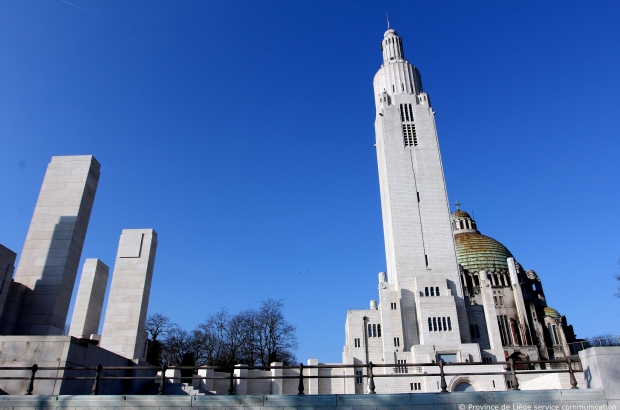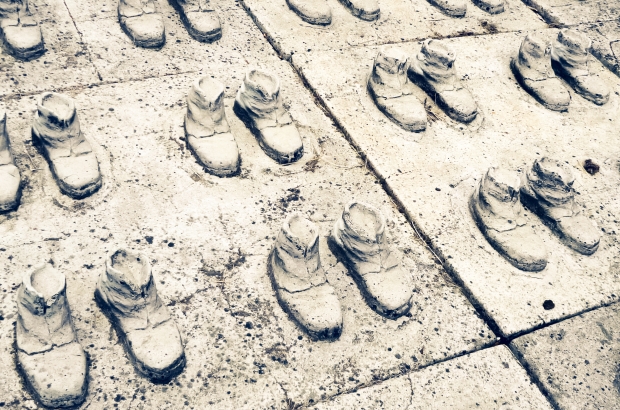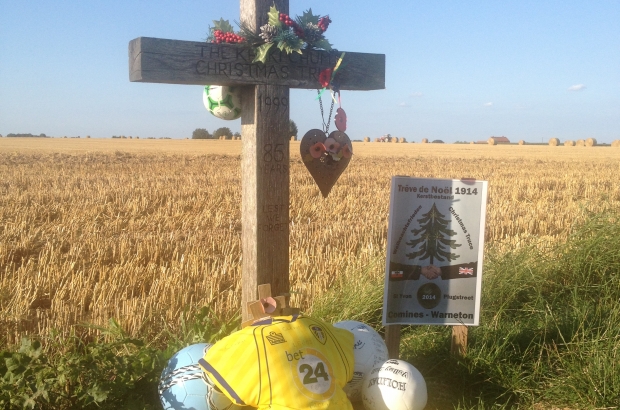- Daily & Weekly newsletters
- Buy & download The Bulletin
- Comment on our articles
Belgium remembers WWI
When people think of Belgium and World War One, they tend to overlook the south of Belgium. Trench warfare and catastrophic loss of life may have been concentrated in West Flanders, yet Wallonia played a crucial role. It was witness to the start of the war in August 1914 and its end in November 1918, the first and last soldiers of the British Forces were killed and are buried in Mons, and it was the backdrop for some of the war’s fiercest fighting.
That is why the eyes of the world turn to Wallonia this summer, for two major events that launch the centenary commemorations in Liège and Mons, both on August 4. The first, at the Inter-Allied Memorial in Cointe, overlooking the city of Liège, marks the 100th anniversary of the invasion of Belgium. Financed by the Allied nations after the war, the symbolic Art Deco tower has been renovated for the occasion. King Philippe, representatives of the Belgian federal government, the Duke and Duchess of Cambridge, Prince Harry, and dozens of heads of state are due to attend. After this ceremony, dignitaries move to Mons’s Saint Symphorien cemetery, for a service on the theme of reconciliation organised by the British Embassy of Belgium. The cemetery, in a quiet rural spot outside Mons, contains the remains of 284 German and 230 British and Commonwealth soldiers.
With more than two million people expected to visit Belgium’s WWI sites over the next four years, Wallonia is pinning its own history to the country’s battlefield map, with events and memorials planned in every province. For centuries Wallonia has been in the crossfire of major geopolitical revolutions, and it is under the banner of memory that the region is promoting battlefield tourism this year. It has three aims: remembrance and heritage, awareness and the economic impact of the war. Wallonia and Wallonia-Brussels Federation are co-ordinating projects including memorials, publications, school and research projects, hundreds of exhibitions and websites dedicated to various aspects of the war and its remembrance.
Education is a key element, explains Claire Duhaut of Wallonia Tourism. “As part of the centenary, pedagogic documents have been drawn up by all the institutions concerned. We are encouraging children to research their own family history and the history of their community.” For many communities, this is a painful experience. Between August and October 1914, more than 5,500 Belgians were massacred and several villages and towns destroyed as the German army moved across the country. Known as the ‘martyr towns’, they included Dinant, Tamines, Andenne, Visé and villages in Luxembourg province. Germany’s justification for killing civilians was reprisal and the policy continued as the resistance movement grew.
The loss of life during WWI was unprecedented. Worldwide it surpassed 20 million, with almost nine million soldiers dying in battle, many of them defending entrenched front lines that barely moved from one year to the next. There were many reasons for the heavy casualties. The nature of warfare had changed. Technological advances included machine guns that could mow down men in swathes, and small-bore, bolt-action rifles that were capable of firing multiple rounds. Early tactics were based on preceding colonial wars, then abandoned for the trench system that required opposing forces to adopt the terrifying and lethal ‘over the top’ tactic. It was not until 1917 that this changed, when small groups of men infiltrated enemy lines, supported by tanks.
How the war started
In 1914 Belgium was a neutral country, its position guaranteed by an 1839 treaty signed by the chief actors of WWI. Although originating in central Europe with the assassination of Archduke Franz Ferdinand, heir to the Austro-Hungarian Empire, the war was the outcome of decades of political tension as countries and empires jostled for power and colonial interests while increasing their militarism. Belgium was a new nation, founded in 1830, and, thanks to its monarchs and constitutional commanders-in-chief, King Leopold II and Albert I, it had begun strengthening its military defences towards the end of the 19th century. Fearing attack by any one of its neighbours, rings of fortresses had been built around the Walloon cities of Liège and Namur. In July 1914, the Belgian army consisted of six divisions with a total of 190,000 men, the majority reservists.
When Germany decided to attack France, Belgium’s puny defences were a tempting alternative to the strong fortifications on the Franco-German border. The day before Germany declared war on France, it wrote to the Belgian government demanding free passage for its troops. Albert I, the ‘soldier king’, famously retorted: “Belgium is a nation, not a road.” But just after dawn on August 4, 1914, the German army crossed the border at Membach, in the strategic province of Liège, and two hours later, lancer Antoine Fonck became the first Belgian soldier to be killed.
The violation of Belgium’s neutrality led to Britain declaring war with Germany; a European conflict became a world war. For centuries, Belgium’s geographical position had earned it the dubious title Battlefield of Europe, to which Cockpit of War was to be added following the two 20th-century world wars. Expecting little resistance, the German army was nevertheless stalled in Liège until a Big Bertha shell hit the powder reserve of Fort Loncin on August 15, killing the majority of the garrison and effectively destroying Belgian resistance. Besieged Namur fell shortly after and the Germans advanced across Wallonia, destroying villages and towns and massacring civilians. Brussels was occupied within two weeks of the declaration of war.
The Belgian army retreated to Antwerp on August 17 while the Germans’ unexpected delay in Liège gave both British and French armies time to amass their forces. It resulted in the Battle of the Frontiers, a series of battles in the south of Belgium and along the eastern frontier of France. Under General Joffre, the Third and Fourth French armies stumbled through the fog in the forests of Luxembourg province on August 21. While German soldiers had already adopted grey uniforms that blended into the terrain, the outnumbered French were still kitted out in the bright red trousers and buttoned blue tunics of the previous century. Over the next two days, casualties rose in battles in Virton, Tintigny, Neufchâteau and Rossignol. Civilians were also killed in these towns. Both armies were forced to retreat to Verdun and Sedan in France. The French Fifth army was similarly under heavy attack in the Battle of the Sambre on August 22. In one day more than 20,000 French soldiers were killed, making it the deadliest in French history. Fighting was particularly fierce in Charleroi and total losses in the Sambre were 16,940 French and 9,335 Germans. As armies fell back, they had to force their way past columns of Belgian refugees, fleeing west.
The Battle of Mons
The small British Expeditionary Force (BEF) had now arrived via French ports and moved into position south of the Mons-Condé Canal on August 23. As the French needed to fall back, the British were requested to hold the canal. Though outnumbered, the BEF was a veteran force with outstanding rifle and machine gun skills. Its first skirmish with Germany began that day, with Drummer Edward Thomas firing the first British shots. Early the following morning the Germans launched an attack on British lines at two bridges over the canal at Nimy. Already prepared, the BEF succeeded in decimating German ranks until the arrival of further troops forced the British to prepare their own retreat. In the early afternoon Mons was abandoned and the British fell back into northern France.
The first two Victoria Crosses of the war were awarded at the Battle of Mons, to machine-gunner Private Sidney Godley, buried at Saint Symphorien, and Lieutenant Maurice Dease. The latter only abandoned his machine-gun after being hit five times. Pte Godley took over the gun and remained in position to cover his comrades’ retreat, despite suffering serious injury himself. There are plaques in memory of both soldiers on the bank of the canal beneath Nimy Bridge.
By September, German armies were advancing towards Paris, until the French launched a surprise attack in the Marne and the BEF exploited a breach in German lines. The German advance had been halted but there was now a race to the sea as both sides moved towards the North Sea. Each built a series of trenches which would characterise the next four years of combat. As the Allies reached Nieuwpoort, German forces descended from Antwerp and thus began the First Battle of Ypres on October 14. In the following weeks, casualties mounted on both sides as German assaults almost succeeded in taking the medieval town. Finally the British held the town and did so until the end of the war. The Allies also controlled a small area extending into German lines. This was the start of a lengthy stalemate in which the line of the Western front was barely to change. Belgium was almost entirely occupied except for a slither of land in northwest Flanders, which would become one of the most strategic areas of Belgium.
The Christmas truce
It includes Ploegsteert in the Comines-Warneton municipality of Hainaut, where an imposing memorial to the missing was built in 1931. It commemorates 11,447 victims whose bodies were never recovered. The new Plugstreet 14-18 Experience recounts the story of the area through film and interactive displays, including semi-underground excavations. Plugstreet was famed for its tunnellers: men who expertly dug deep beneath enemy lines to lay down explosives. The striking glass pyramid is also the entrance to catacombs and the Australian contribution to the Battle of Messines. The majority of Commonwealth soldiers who fought in Belgium, spent time in the Plugstreet catacombs. Among them was Winston Churchill, who abandoned politics and returned to his regiment after masterminding the disastrous Gallipoli campaign in 1915. His energetic and non-disciplinary command quickly gained respect from his battalion. Plugstreet is also the location of the famous Christmas truce football match; a cross, tributes and muddy footballs mark the unassuming site.
When soldiers left the UK in the autumn of 2014, it was presumed they would be home for Christmas. Alas not, though when the guns fell quiet on the evening of December 24, soldiers from both sides spontaneously sauntered into No Man’s Land. They chatted, exchanged gifts, sang carols and famously played a football match. It was an unofficial event that was never repeated. The guns were not to be silenced until the signing of the armistice in November 1918. It followed the abdication of the German Kaiser Wilhelm II on November 9 at his army headquarters in the town of Spa, a few miles from where the war had begun.
www.belgium-tourism.be
www.be14-18.be/en
www.thefirstandthelast.co.uk
The Angel of Mons
One of the most vivid legends of the war is the Angel of Mons. During the night of August 23, 1914, exhausted British troops retreated, still fighting, along a forested Roman road into France. In the sky they saw an odd cloud formation, appearing like an angel and interpreted as a supernatural intervention that protected them from the German forces. Rumour quickly became legend, which now has its place in the city’s European Capital of Culture programme for 2015. The Angels of Mons 1914-1918 is an illustrated novel by contemporary writer Xavier Hanotte and illustrator Claude Renard. There are English and French versions available from www.mons2015.eu. The city commemorates the Battle of Mons on August 23 with a sound-and-light show celebrating the mythical angel, one of numerous events planned alongside the opening this year of Mons Memorial Museum, dedicated to war and peace.
Loncin Fort
The symbol of Liège and Belgium’s heroic resistance, the triangular semi-buried fort of Loncin is an evocative site and a memorial to hundreds of soldiers who lost their lives in its final battle. Between 1888 and 1892 the fort was modernised by the revolutionary General Henri-Alexis Brialmont, one of the leading military engineers of the period. His mission was to strengthen the forts around the strategic cities of Liège, Namur and Antwerp. The role of Loncin was to defend road and rail links to Brussels; guns within the fort provided backup for infantrymen positioned outside as well as suppressing enemy artillery. After Germany’s invasion of Belgium, Liège commander General Leman made Loncin his headquarters when other forts fell. The Germans needed to capture all 12 if they were to advance north and west. The resistance in Liège was so harsh that extreme firepower was necessary. They fetched from the Krupp factory in Germany the Big Bertha howitzer, a secret weapon planned for use against the French Army. On August 15, one of its shells hit one of the two powder rooms, causing an immense explosion that killed around 350 of the 550-strong garrison. Some 200 soldiers remained where they fell, buried under tons of concrete. The fort was indefensible and the remaining forts quickly surrendered.
In honour of Liège’s resistance, the city was awarded the Legion d’honneur by France, the only foreign city to ever be awarded the honour. In tribute to Liège’s resistance, Parisian waiters renamed café viennois, café liégeois. For years the Loncin site remained a necropolis, fenced off from the public because of the danger posed by buried munitions. In 2007, the Belgian army demined the area, removing more than 2,500 unexploded shells and inadvertently uncovering 25 bodies, four of whom were identified. Now open to the public and manned by enthusiastic volunteers, Loncin is a fascinating and moving tribute to Belgium’s military resistance. Underground passages reveal the living conditions of hundreds of soldiers, while above ground, there remain searchlights, the enormous turrets and the vast devastation caused by the explosion.
Resistance heroine Gabrielle Petit
Executed in Brussels in 1916 at the age of 23, Gabrielle Petit from Tournai was a British Secret Service spy. A statue to the resistance worker stands in Place Saint-Jean in Brussels, showing her defiantly looking up to the sky. At the outbreak of the war she was living in Brussels and volunteered for the Belgian Red Cross. She first became involved in the resistance when she helped her wounded fiancé escape to the Netherlands. British intelligence recruited her to spy on the German army in the area south of Ypres. She also set up a network to bring Allied soldiers to safety (as did Edith Cavell, the British nurse executed in 1915), served as a courier for the underground mail service Mot du Soldat (Soldier’s Word) and distributed the clandestine newspaper La Libre Belgique. Arrested for a second time in January 1916, she refused to provide information about the network and names of people involved, and was sentenced to death. Due to the international furore following the shooting of Cavell, the Germans told Petit that if she appealed her sentence would probably be commuted. She refused. When facing the firing squad, she rejected a blindfold and famously said “I shall show them that a Belgian woman knows how to die.” The Germans kept her death a secret and her story only emerged after the war.
Victoria Cross heroes
Both Private Godley and Lieutenant Dease displayed enormous courage, according to Brussels-based tour guide and former British army soldier Willie Mohan. “Dease, from an Anglo Irish family, died of his wounds in German captivity that evening. As the man in charge of machine guns placed to stop the Germans crossing the bridge, he and the gun teams were very exposed and decimated by fire. Dease moved from one gun to the next as this happened, sometimes firing the gun himself, all the time encouraging the men until he was hit and mortally wounded. Sid Godley, was told to man a gun himself and hold the Germans back as his company retreated. Then , despite being badly wounded, he took all the machine guns to pieces and threw the parts into the canal. He crawled off as badly wounded as Dease, until he was found by Belgian civvies who looked after him before handing him over to the Germans. This was a good idea, as otherwise they would have been shot. He was told of his VC whilst in POW camp and the German officers took him off to their mess for a celebratory meal.”
This article was first published in Wab, Spring 2014






















